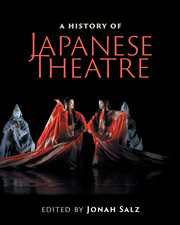Book contents
- Frontmatter
- Contents
- List of figures
- List of tables
- Contributors
- Contributors’ biographies
- Foreword
- Acknowledgments
- Note on Japanese terms
- List of abbreviations
- Timeline
- Editor's introduction
- I Traditional theatres
- Preface to Part I Japanese civilization arises
- II Modern theatres
- Preface to Part II
- III Arcs and patterns
- IV Theatre architecture
- Preface to Part IV Evolution of Japanese theatre architecture
- V Theatre criticism
- 19 Premodern practitioner principles: Zeami to Chikamatsu
- 20 Modern criticism: wrestling with Western realism
- 21 English language scholarship: a critical overview
- Interlude University scholarship and training
- VI Intercultural influences
- Epilogue: Frozen words and mythology
- Further reading
- Index
- References
20 - Modern criticism: wrestling with Western realism
from V - Theatre criticism
Published online by Cambridge University Press: 05 July 2016
- Frontmatter
- Contents
- List of figures
- List of tables
- Contributors
- Contributors’ biographies
- Foreword
- Acknowledgments
- Note on Japanese terms
- List of abbreviations
- Timeline
- Editor's introduction
- I Traditional theatres
- Preface to Part I Japanese civilization arises
- II Modern theatres
- Preface to Part II
- III Arcs and patterns
- IV Theatre architecture
- Preface to Part IV Evolution of Japanese theatre architecture
- V Theatre criticism
- 19 Premodern practitioner principles: Zeami to Chikamatsu
- 20 Modern criticism: wrestling with Western realism
- 21 English language scholarship: a critical overview
- Interlude University scholarship and training
- VI Intercultural influences
- Epilogue: Frozen words and mythology
- Further reading
- Index
- References
Summary
Starting with journalists and interested amateurs, the twentieth century saw the emergence of a new “industry” of documenting, analyzing, and speculating upon the rapidly changing theatre scene. Japan has also been fortunate to have nurtured many playwright-directors who have written on their own work and that of others, as well as on more general issues of importance to theatre practitioners. While theatre was late to gain recognition as a subject worthy of academic study, there are a number of university programs, especially in Tokyo, which train stage professionals and academics, the latter contributing to scholarly debate in domestic research groups as well as international critical discussions on contemporary Japanese theatre.
The early reception of modern Japanese drama
The first fifty years of theatre criticism following the Meiji Restoration in 1868 were devoted to Westernization and rationalization of existing practices and conventions, thus largely centered on kabuki, the dominant theatrical genre. The actual movement toward theatrical reform began in 1886 with the Theatre Reform Society established by diplomat Suematsu Kenchō, who had studied literature at Cambridge. Members came from the political, business, and academic elites. Sociologist Toyama Masakazu produced what was the first treatise on theatre reform in modern Japan, Engeki kairyōron shikō (A personal view of theatre reform, 1886), followed the same year by a similar work by Suematsu. Both argued for the greater amenability of kabuki to upper-class audiences, for example by replacing female role specialists (onnagata) with female actors, the abolition of the hanamichi walkway and raised chobo platform of jōruri narrators and shamisen players, a review of the system for selling tickets through teahouses attached to theatres, the radical improvement of playscripts, and the construction of Western-style theatres, of which the principal model at that time was the opera house. Yet such proposals were summarily rejected as superficial by theatre aficionados and literati such as Tsubouchi Shōyō, the pseudonymous Muichian Muni and Nihontei Shōfū, and Mori Ōgai.
Alternative views of the development of a modern theatre also emerged from Ishibashi Ningetsu, who called for a Western-style dramaturgy based on Aristotle and Lessing (1890), while Nagai Tetsu (1884) and Taniguchi Masanori (1887) adopted chronological Western styles of historiography to explain Japanese drama. Newspaper critics, such as Aeba Kōson, Sugi Ganami, Matsui Shōyō, Oka Onitarō, Morita Shiken, and Okamoto Kidō, campaigned for better plays less subject to the preferences of theatre owners.
- Type
- Chapter
- Information
- A History of Japanese Theatre , pp. 454 - 462Publisher: Cambridge University PressPrint publication year: 2016



